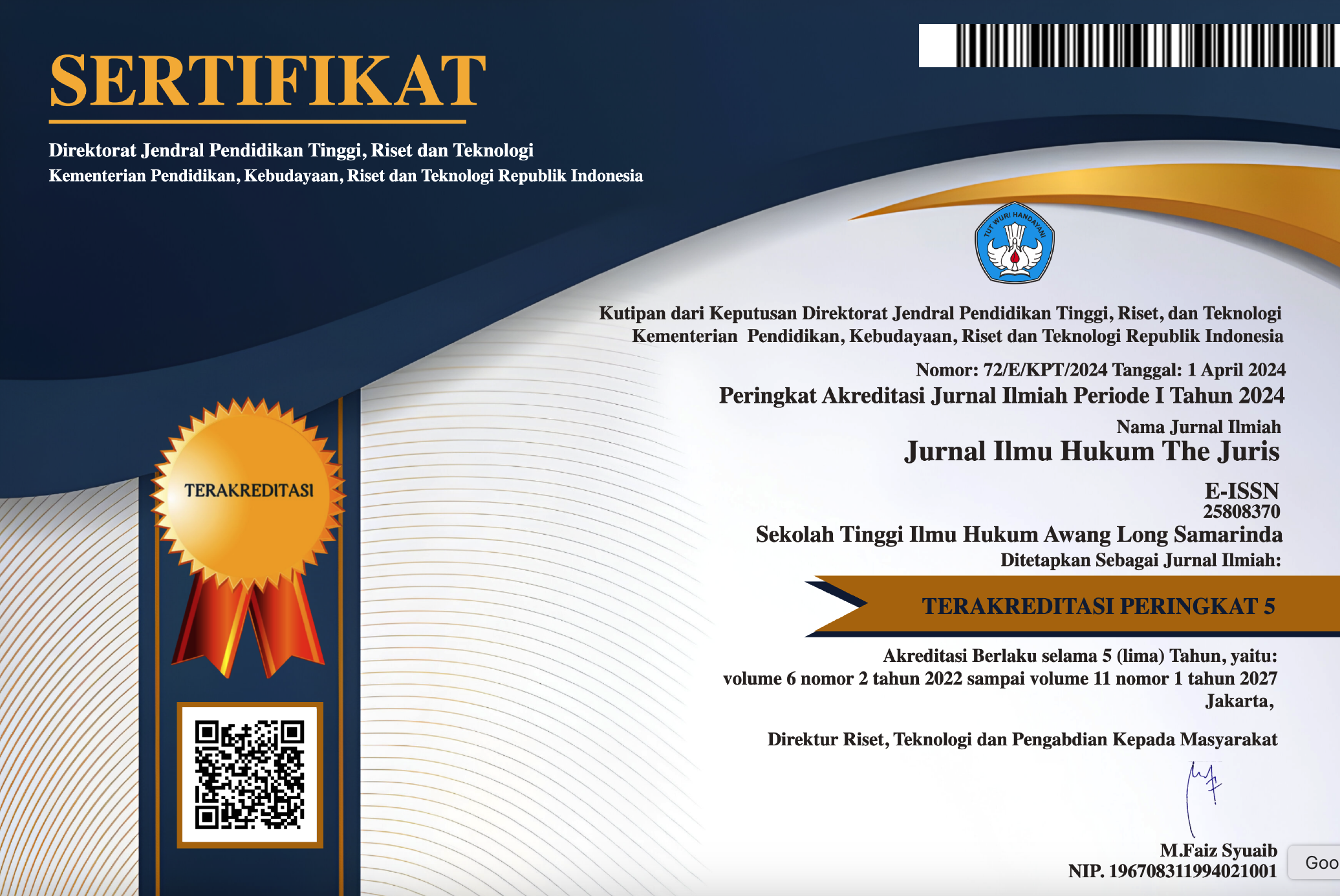THE POSITION AND PROTECTION OF CONCURRENT CREDITORS IN INDONESIA’S BANKRUPTCY PROCESS: A REVIEW BASED ON THE PRINCIPLE OF CREDITORIUM PARITY
Abstract
This research aims to analyze the position and protection of concurrent creditors in Indonesia, particularly in the context of Decision Number 113/Pdt.Sus-PKPU/2019/PN.Niaga.Jkt.Pst. Using normative research methods, this study examines primary, secondary, and tertiary legal materials to address challenges faced by concurrent creditors in bankruptcy proceedings. The findings highlight the implementation issues of creditorium parity and provide recommendations for enhancing the legal framework. The research process involves inventory and identification of relevant legal materials, including primary, secondary, and tertiary sources. The stages of processing include the systematic collection and examination of these sources to analyze issues related to concurrent creditors in bankruptcy cases. Through an analysis of statutory provisions, court decisions, and practical bankruptcy procedures, this research reveals that while the principle of creditorium parity aims to ensure fair and balanced treatment among creditors, its implementation faces significant challenges. These challenges include differences in the positions of concurrent creditors, separatist creditors, and preferred creditors, as well as the complexities and bureaucratic nature of the bankruptcy process, which often hinder concurrent creditors from obtaining their rights.Court decisions, such as Decision Number 113/Pdt.Sus-PKPU/2019/PN.Niaga.Jkt.Pst., demonstrate that the position of concurrent creditors is protected under Articles 1131 and 1132 of the Civil Code. This decision confirms that concurrent creditors have equal rights in creditor meetings, based on the amount of their claims.
Downloads
References
Ashhadie, Z. (2009). Business Law: Principles and Implementation in Indonesia, cet IV. Rajawali Press.
Black's Law Dictionary. (2004). Black's Law Dictionary Ed. IV. USA: West Group.
Dating, I. (2004). The Role and Responsibilities of the Curator in the Management and Settlement of Bankruptcy Assets. Jakarta: RajaGrafindo Persada.
Diarsa, KOF, Yuniati, E., Surahmat, & Yurisar Akbar, T. (2023). Legal Protection for Directors or Tax Bills Still Due After Settlement of Bankruptcy Assets. Notaire, 6(2), 237–256. https://doi.org/10.20473/ntr.v6i2.43650
Hindrawan, P., Sunarmi, S., Ginting, B., & Harianto, D. (2023). Curator's Responsibilities in Applying the Pari Passu Prorata Parte Principle in the Management and Settlement of Bankruptcy Assets. Locus Journal of Academic Literature Review, 2(8), 720–732. https://repository.usu.ac.id/handle/123456789/89583
Inaugurate, R. (2007). Critical Study of Legal Protection of Mortgage Rights in Debtor Bankruptcy. Yogyakarta: Total Media.
Kusmadi, B., Ismail, & Iryani, D. (2023). Legal Protection for Concurrent Creditors in the Bankruptcy Process Concerning the Debtor's Remains Confiscated by the Prosecutor's Office. Journal of Business Law, 12 (3), 117–129.
Ministry of Law and Human Rights National Legal Development Agency. (2018). Academic
Manuscript of Draft Law Concerning Amendments to Law of the Republic of Indonesia Number 37 of 2004 concerning Bankruptcy and Postponement of Debt Payment Obligations. Ministry of Law and Human Rights National Legal Development Agency.
Nawi, S. (2014). Normative Legal Research Versus Empirical Legal Research. Makassar: Umitoha Publishers.
Raharjo, S. (2020). Legal studies. Bandung: PT Citra Aditya Bakti.
Saputra, IE (2020). Legal Position of Tax Preferred Creditors and Labor Preferred Creditors in the Bankruptcy Process. Al-Ishlah: Legal Scholarly Journal, 23 (2), 155–166.
Sirait, P., Junaidi, M., Sudarmanto, K., & Sofyan, S. (2023). Revocation of the Bankruptcy Decision if the Bankruptcy's assets are insufficient to pay the bankruptcy costs. Usm Law Review Journal, 6 (3), 1279. https://doi.org/10.26623/julr.v6i3.7911
Sjahdeini, SR (2002). Bankruptcy Law. Jakarta: Graffiti Main Library.
Subhan, H. (2008). Bankruptcy Law, Principles, Norms, and Practice in Court. Surabaya: Kencana.
Wulandari, T. C., Fajarianto, O., & Abidin, Z. (2024, January). PENINGKATAN MUTU GURU MELALUI PEMANFAATAN WORDWALL PADA PEMBELAJARAN BERBASIS GAMIFIKASI. In PROSIDING SEMINAR NASIONAL PENELITIAN DAN PENGABDIAN KEPADA MASYARAKAT (SNPP) (Vol. 3, pp. 37-44).
Copyright (c) 2024 M. Adnan Lira

This work is licensed under a Creative Commons Attribution-ShareAlike 4.0 International License.







